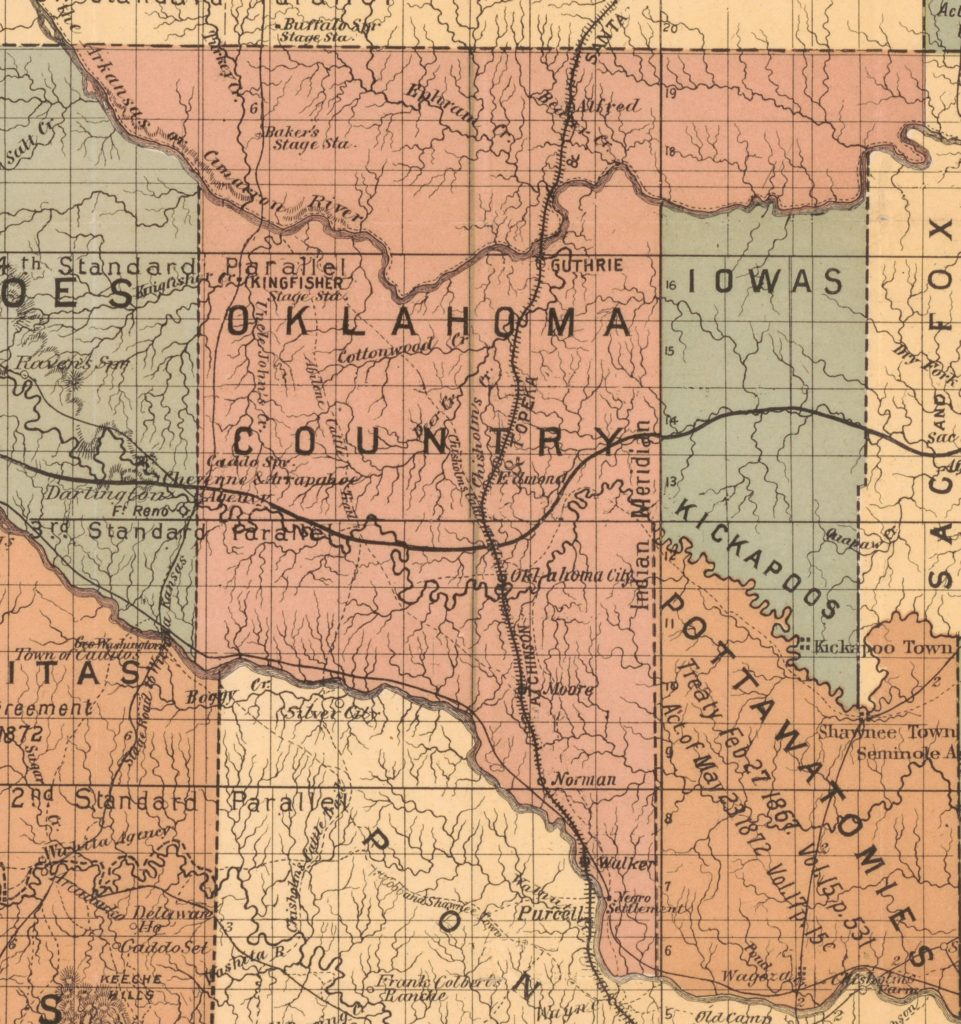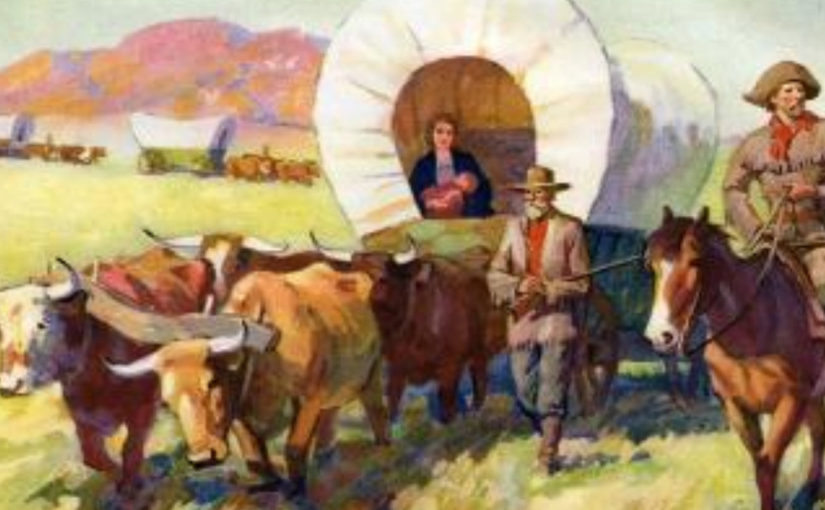The rewriting of history is a hallmark of tyranny.
And today, just like what happened in China during the Cultural Revolution, “modern” and “progressive” busybodies are active in changing society to embrace their own idea of perfection. And much of that involves erasing history, and rewriting it to fit their ideas of perfection. What ever they might be.
Here is a great story of one such event. Here, a “busybody” is successfully rewriting history to pave the way for more aggressive progressive changes in her realm of control.
Crazies inhabit both sides of the political spectrum. Both are dangerous to the stability that us “normals” need to conduct our lives in peace.
- ‘Pet Shop Karen’ Calls 911 After Being Told to Put On Her Mask – Towleroad

The following is an article titled “How did the Unassigned Lands become unassigned?” By Michael Bates on September 15, 2020 12:09 AM. It was edited to fit this venue and all credit to the author.
How did the Unassigned Lands become unassigned?
This past April 22, 2020, was the 131st anniversary of the land run that opened the central part of today’s State of Oklahoma to homesteading by non-Indian settlers. These were lands owned by the U. S. Government and not assigned to any organized territory nor to any Indian nation or reservation. It was the first time and one of a handful of times that land was allocated based on who could get there the quickest. Tent cities with populations in the thousands sprung up in a matter of hours after the guns were fired to start the run. The land runs, particularly the first land run in 1889, constitute an aspect of Oklahoma’s history unmatched by any other state, and, as far as I’m aware, any other region of the world.
For many years, April 22 was marked at elementary schools across Oklahoma by land run reenactments. Kids would come to school dressed in cowboy hats and denim overalls or bonnets and gingham dresses, would line up at the edge of the football field, some pulling Radio Flyers made up as covered wagons. At noon, they would rush across the sideline to drive a stake in the ground, claim a homestead, and eat a picnic lunch.
But this fun, child-friendly introduction to Oklahoma’s unique history is threatened by a handful of busybody killjoys who distort the real story of how the 1889 Land Run territory came to be available for settlement and by the school officials who cave into their demands. I’ve done some digging into the treaties and agreements leading up to the 1889 run, and what strikes me is that the U. S. Government bent over backwards to give the tribes that previously held the land a fair deal.
When I was a third-grader, our land-run reenactment was the culmination of a few weeks of focus on Oklahoma history. We learned to square dance. We studied the map of tribal lands before statehood. We learned about the Trail of Tears. On land-run day, teachers led a re-enactment of the one-room school house, complete with dunce cap. One of the covered wagons, belonging to a young Chip McElroy, was motorized, thanks to the assistance of his dad, Art McElroy, then head of McElroy Manufacturing. KOTV covered the re-enactment that year, and the closing credits of that night’s newscast crawled over footage of one of my classmates relieving himself, pioneer style, against a tree.
All of my own children have participated in land-run re-enactments — at “The Barn” at 109th & Louisville, on Augustine Christian Academy’s grailball field, and at Harn Homestead in Oklahoma City, where Lt. Gov. Todd Lamb signed the homestead claims. It’s a fun event that provides a memorable hook on which to hang a beginning understanding of our state’s unusual origins.
Unfortunately, Leftist activists have been persuading schools to drop the land-run reenactments by claiming that Land Run reenactments are celebrations of genocide and land theft. In 2014, the Oklahoma City school board banned reenactments. A Leftist activist named Sarah Adams-Cornell had already persuaded all but one classroom in the district to drop the activity — this in a city that owes its very origin to the 1889 Land Run — making unsubstantiated claims that 10,000 Indians were made homeless by the Land Run and that “in many cases land grabbers walked right into a house and took over.”
As far as I have been able to find, Adams-Cornell offered no evidence for her claims. The first instinct of a typically risk-averse school bureaucrat, when confronted with a claim of oppression by someone who ticks several intersectional boxes, would be to capitulate immediately, without asking for evidence. To resist in even the mildest terms would bring protests and bad publicity, but immediate compliance would bring praise for virtue-signaling.
There is no question that American Indian nations suffered great oppression and hardship at the hands of the U. S. Government, particularly in the passage and enforcement of the Indian Removal Act of 1830. But the guilt that attaches to the actions of Andrew Jackson or, say, gold-hungry north Georgia settlers, doesn’t necessarily attach to the ’89ers who staked claims on the Unassigned Lands. We need to look at the documentation and understand exactly how these lands came to be unassigned.

Indian territory: compiled under the direction of the Hon. John H. Oberly, Commissioner of Indian Affairs, by C.A. Maxwell, 1889. Click on the map to view a high-resolution version on the Library of Congress website. The map shows various tribal assignments and cessions, using colored numbers and outlines and a numbered legend in the upper right corner. Significant treaty dates are noted on the map.
The Unassigned Lands were part of the lands purchased from the Creek and Seminole Nations under the 1866 treaties following the Civil War. The two nations had signed treaties with the Confederacy at the start of the war, in violation of their treaties with the U. S. government. Despite official Creek and Seminole support for the rebellion, the Federal government didn’t simply claim their lands as spoils of war. Instead, the U. S. paid the two nations for their western, unoccupied lands, ($975,168 to the Creek Nation, $15,673,385.66 in 2019 dollars; $325,362 to the Seminole Nation, $5,229,283.55 in 2019 dollars, less $100,000 to the Creek Nation for a new reservation), and then settled several Plains tribes on the land, including Pottawatomie, Iowa, Kickapoo, Sac and Fox, Cheyenne, and Arapaho. Some of the funds were earmarked for paying reparations to Creek and Seminole citizens who remained loyal to the Union during the war and suffered losses as a result.
When the U. S. wanted to open the Unassigned Lands — lands that had not been reallocated to other Native peoples — for non-Native settlement, they had to get permission from the Creek and Seminole Nations, because the 1866 treaty only allowed for other Native tribes and freedmen to be assigned reservations within the ceded land. In 1885, Congress authorized new negotiations to remove the deed restriction on the land:
Most of the enthusiastic home seekers did not then know of that clause in the treaty of 1866--whereby the surplus lands of both the Creeks and Seminoles were ceded back to they United States for the purpose of "locating other friendly tribes of Indians and freedmen." While no other Indians or freed Negroes were to be located on the land, yet the government claimed that while the cloud was on the title, no white citizen would be permitted to make settlement. By an Act of March 3, 1885 [48th Congress, Session 2, Chapter 341, Section 8], a commission was appointed to negotiate a new deal with these two tribes whereby the clause as to the "friendly Indians and Freedmen" would be stricken from the treaty of 1866 and the unassigned lands would be, without question, public domain and opened to homestead settlement. The negotiations were concluded and the price agreed upon before the country was opened. ("Colonel Crocker and the Boomer Movement, Chronicles of Oklahoma, Volume 13, No. 3 (September 1935), p. 275 [21], hyperlink added)
The 1889 agreements required the U. S. Government to pay a further $2.2 million to the Creek nation [50th Congress, Session 2, Chapter 317] and $1.9 million to the Seminole nation [50th Congress, Session 2, Chapter 412, Section 12] — that’s in 1889 dollars. The only people authorized to live in the Unassigned Lands between the sale of the land in 1866 and April 22, 1889, were railroad workers and Federal marshals.

From Rand McNally, 1889, “Map of the Indian Territory showing Oklahoma country “
(And who had the land before the Creeks and Seminoles? Nearly all of present-day Oklahoma was part of the land ceded by the 1825 treaty with the Great Osage and Little Osage Nations. The Osage tribes, with a population of about 4,000 in 1807, had villages in western Missouri and a colony along the Grand River that was founded circa 1796 under the leadership of Chief Clermont (namesake of Claremore) and with the encouragement of fur trader Pierre Chouteau.
With the 1825 treaty, they ceded all their claims for a 50-by-150 mile reservation in southern Kansas. A small number of mixed-blood Osage were granted homesteads along the Grand River. The specific territory that became the Unassigned Lands might have been used as hunting grounds — Washington Irving’s party came across Pawnee and Osage hunters and warriors in the region — but don’t appear to have been settled by any tribe.)
At noon on April 22, 1889, guns were fired and settlers began streaming across the border into a region known as the Unassigned Lands, trying to stake a claim on one of the best quarter-sections for homesteading or a good lot in the new townsites along the Santa Fe railroad, like Guthrie, Edmond, Oklahoma City, Moore, and Norman. They were beaten to some of the best land by “Sooners,” who were in the territory illegally, having stolen across the border ahead of the gun, and by federal officials and railroad workers, who were in the territory legally but were legally barred from competing for lots and homesteads. Collectively, these settlers became known as the Eighty-Niners — the original settlers who were renowned for their grit and determination to survive the harsh conditions on the prairie.
A first-hand account by William Willard Howard, published a month after the Land Run in Harper’s Weekly, paints a vivid picture of the chaos and hardship of those early days. (A note to the reader: Howard uses the name Oklahoma to refer specifically to the Unassigned Lands opened by the ’89 run, not the larger Oklahoma Territory or present-day State of Oklahoma.)
A year later, in 1890, Congress and President Benjamin Harrison would approve the Organic Act for Oklahoma Territory, establishing Oklahoma Territory as a non-contiguous collection of the Unassigned Lands, the Public Land Strip (better known as No Man’s Land and the Panhandle), and the tribal lands that had been assigned after the end of the Civil War (e.g. Pawnee, Tonkawa, Sac and Fox, Pottawatomie). This excluded the portion of the Cherokee Outlet that had yet to be assigned to another tribe or opened for settlement, and the area that the act would, for the first time, officially designate as Indian Territory: the lands of the Five Civilized Tribes, and the tribal lands overseen by the Quapaw Agency near present-day Miami.
The Cherokee Outlet lands would be added to Oklahoma Territory at a later date. The territorial capitol would be at Guthrie, and the territorial government would be elected by the residents of the former Unassigned Lands and No Man’s Land. Greer County, the land between the north and south forks of the Red River, was also excluded from Oklahoma Territory until the boundary dispute between the State of Texas and the Federal Government could be settled by the courts.
The Organic Act makes references to agreements made with the Muscogee (or Creek) Nation, ratified by Congress on March 1, 1889, and with the Seminole Nation, ratified by Congress on March 16, 1889. The western lands that the two nations had ceded to the United States in the post-Civil War treaties of 1866 could only be occupied by peaceful Indian tribes. In order to open the lands to non-Indian settlement, the government had to negotiate an additional treaty with the Creeks and the Seminoles, which included a significant amount of money.
Pursuant to the 1889 agreement, the US made an immediate payment to the Muscogee Creek Nation $280,857.10, and held an additional $2,000,000 in a trust account at 5% annual interest, to be paid to the tribe semi-annually — $50,000 every six months, in addition to the government’s existing financial obligations under earlier treaties. That’s an immediate payment of $7,760,264.84 in 2019 dollars, and a semi-annual payment of $1,381,532.61. An 1890 tribal census counted 14,800 Creeks. These interest rates were set at 5% at a time when the economy was deflating — prices declined by 3.16% in 1889. In the 18 years between 1889 and statehood in 1907, prices rose only by 2.17%
The Seminoles received $412,942.20 immediately, and an additional $1,500,000 in a trust account at 5% annual interest — $37,500 every six months. In 2019 dollars, that’s $11,409,862.30 immediately and $1,036,149.46 every six months. The 1890 census counted 2,427 Seminoles.
Critics may argue with the amount of money that was paid, or the way in which it was paid. It’s fair to say that the Creeks and Seminoles were not in a strong negotiating position after the Civil War or in 1889, but, nevertheless, the U. S. Government didn’t simply say, like Darth Vader, “I am altering the deal; pray I don’t alter it any further.” If the U. S. Government had simply forced its will without compensation — claiming the land as spoils of war and later modifying its deed restrictions — who would have stopped it? Instead, whether from moral convictions or from concern for its reputation for treaty fidelity in the wider world, the U. S. Government negotiated and paid for the changes it sought.
The result was an unoccupied region of two million acres to which the U. S. Government had clear legal and moral title, ready for settlement by Americans who were desperate for land to farm.
NOTE: I started writing this in April of 2019, hoping to finish in time for that year’s anniversary of the 1889 Land run, but it has been sitting in draft since that time. I had in mind to delve deeper into some details, but at this point, I simply want to publish what I have, as I find I keep referring to the information in online discussions.
Conclusion
It is so easy for us to politicize everything. The progressives are bad, and the traditional conservatives are good, and all that “rot”. But the fact is that most people are just trying to live life in the best way that they know how, and in America today there are no “speed brakes on the roller coaster”. No one is reining in the crazies.
Busybodies are crazies. They are people with serious mental illnesses and they tend to be unemployed because they simply are unable to function within society. They are on BOTH sides of the political spectrum.
- Progressive crazies tend to be SJW types.
- Conservative crazies tend to be neocons.
This is just another story of a busybody, and just because no one is reporting on their lunacy, doesn’t mean that it isn’t going on. It is, and it’s “off the rails” out of control. As this simple article illustrates.
In this case, what’s their disconnect? WTF? Don’t they have better things to do with their time?
Apparently not.
And in our modern contemporaneous life please recognize that the “news” does not report events. They try to manipulate. And much of what is going on all around you is indeed all sorts of social re-engineering by dangerously crazy and malevolent individuals.
Head’s up.
Do you want more?
I have more posts in my Happiness Index here…
Life & HappinessArticles & Links
You’ll not find any big banners or popups here talking about cookies and privacy notices. There are no ads on this site (aside from the hosting ads – a necessary evil). Functionally and fundamentally, I just don’t make money off of this blog. It is NOT monetized. Finally, I don’t track you because I just don’t care to.
To go to the MAIN Index;
Master Index.
- You can start reading the articles by going HERE.
- You can visit the Index Page HERE to explore by article subject.
- You can also ask the author some questions. You can go HERE .
- You can find out more about the author HERE.
- If you have concerns or complaints, you can go HERE.
- If you want to make a donation, you can go HERE.
Please kindly help me out in this effort. There is a lot of effort that goes into this disclosure. I could use all the financial support that anyone could provide. Thank you very much.
[wp_paypal_payment]


